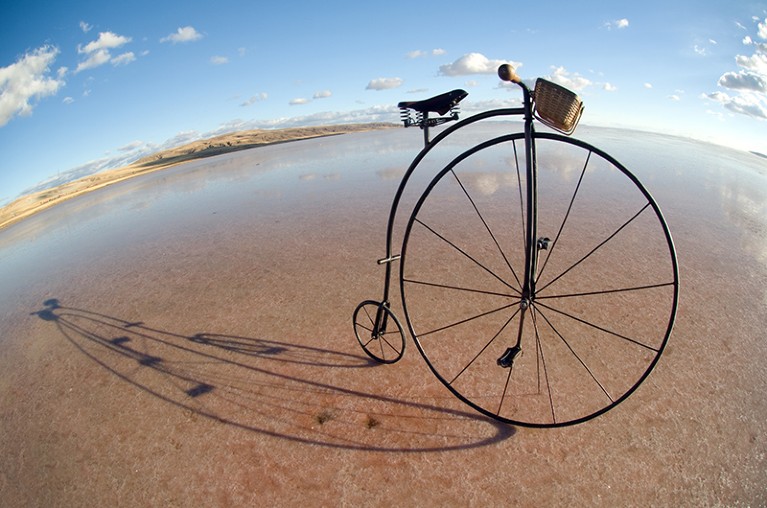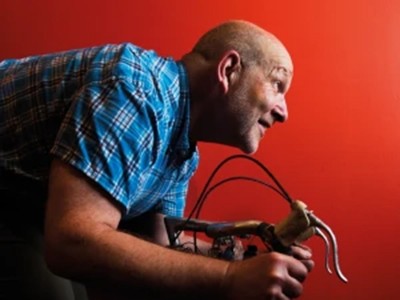
Centuries of development led to the bicycle’s spoked wheel — which brought mobility and freedom for many.Credit: Getty
Nuts and Bolts: Seven Small Inventions That Changed the World (in a Big Way) Roma Agrawal Hodder & Stoughton (2023)
Ten thousand years ago, the most advanced tools were made of chipped stone. Today, much technology is so complicated that it’s almost “indistinguishable from magic”, to borrow Arthur C. Clarke’s phrase. How did we get here? In Nuts and Bolts, structural engineer Roma Agrawal investigates the story of basic technological developments, and shows how intimately entwined they are with humanity’s own history.
She contends that the modern world has its foundations in seven humble inventions: the nail, wheel, spring, magnet, lens, string and pump. Building on her lifelong fascination with opening things up to see what makes them work, she explores the science of each of these mini ‘machines’, and follows their history from ancient beginnings to manifestations of modern engineering, small and large.
The spring, for example, she characterizes as “humanity’s first tool that allowed us to store energy and then release it when we wanted”. She charts its development from bows and arrows to the vast steel coils that help skyscrapers to withstand earthquakes, and the silicon hairsprings that maintain the accuracy of the most exclusive mechanical watches.

The bicycle problem that nearly broke mathematics
With a clear, lively and engaging style — and many puns — Agrawal encourages a new perspective on the inventions that keep the world rolling. The wheel, she explains, was first used not for transport, but to make pottery. It wasn’t for another 700 years that it was turned on its side and attached to an axle; the earliest surviving wheeled vehicles are from around 3200 bc, in what’s now Russia. A multitude of refinements followed, technological advances ushering in sweeping social change. Spoked wheels supplanted solid ones, their lightness enabling fast travel and improved trade. Wheels with wire spokes led to the bicycle, a source of freedom for many who couldn’t afford carriages or cars.
Gear change
Table of Contents
Serrated wheels became gears, tools for changing the direction and magnitude of forces that prompted advances of the Industrial Revolution and beyond. In the late nineteenth century, for instance, Josephine Cochran used wheels and gears to develop the first commercially viable dishwasher — one of myriad appliances that would cut the time spent on housework and free many women to enter the workforce. And wheels are ancestors of the gyroscopes that steer the International Space Station. As Agrawal says, 5,000 years of change have been driven by constant reinvention of the wheel.
Refreshingly, this world-trotting tale focuses on “the often hidden or unacknowledged contribution of minoritised people”. Soviet women work as fighter pilots in the Second World War; spinning wheels take a key role in the Indian independence movement. Even familiar names have an unexpected spin. Telephone inventor Alexander Graham Bell, for example, originally set out to convert the vibrations of speech into something that his mother and wife, both deaf, could see.

Degrowth can work — here’s how science can help
The global tapestry is shot through with Agrawal’s personal stories. She makes her own nails at a blacksmith’s forge, and describes movingly how she owes the birth of her daughter to the lens, without which the microscopes that were crucial to the development of in vitro fertilization (IVF) would not have existed. Her family history illustrates how using magnets to modulate electric pulses enabled technologies that have repeatedly revolutionized global communications. Her uncle, looking for work in Italy in the 1960s, sends telegrams to his family in Mumbai, India. An aunt in Connecticut in the 1970s books a trunk call across continents through a network of telephone exchanges. Agrawal’s daughter speaks her early words to her own grandmother by video call during the COVID-19 pandemic.
All that glitters
The reader can’t help but be swept along in Agrawal’s enthusiasm, but she’s at pains to point out that ‘progress’ isn’t always good. Spoked wheels made chariots nimble enough to be used in war. Springs are crucial to guns. String led to a textile industry that bankrolled the British Empire while laying waste to the Indian economy (hence the significance of the spinning wheel). The fashion industry now generates around 10% of global carbon dioxide emissions and vast amounts of other pollution.
The question of engineering’s impact on the planet and on society is a common thread. By drawing out stories of technology’s use for good and ill, Agrawal encourages deep thinking about where we go from here.
She shows how, to manage humanity’s devastation of the planet, we must demystify the ‘black box’ of technology. “Understanding the nuts and bolts of our objects”, she says, leads us to appreciate the effort, ingenuity and raw materials that went into them, and stop seeing them as disposable. We become more likely to find ways to extend their lives, to reconstitute and repair them. Agrawal points to sustainable engineering practices, community-awareness programmes and repair movements as ways to help fend off environmental disaster. On an individual level, taking ownership of our possessions through repair brings a fulfilling “sense of happiness, satisfaction, and achievement”.
So the history of engineering tells us about who we are and who we have been. It can even lead us to who we want to be.
Competing Interests
The author declares no competing interests.
